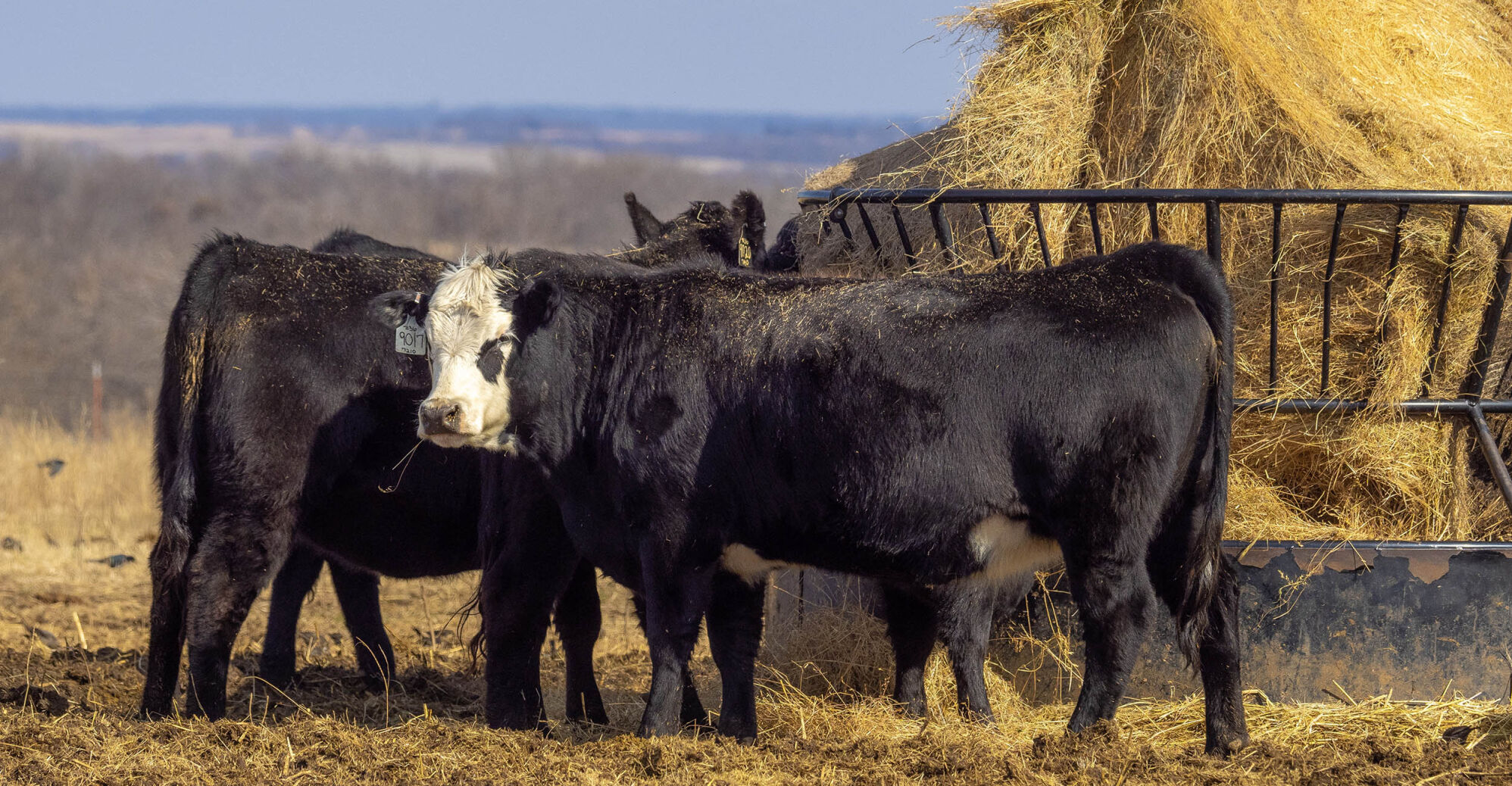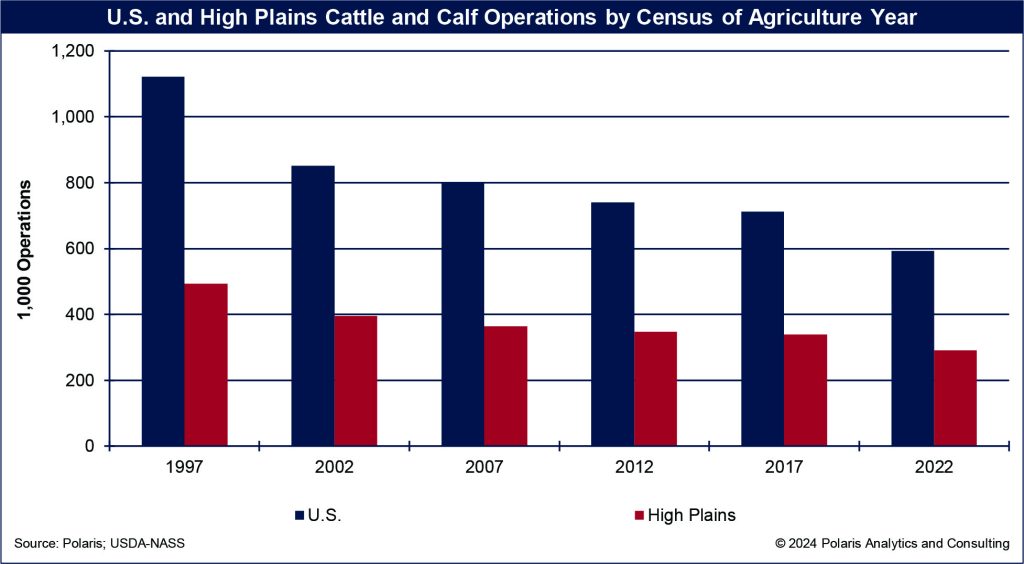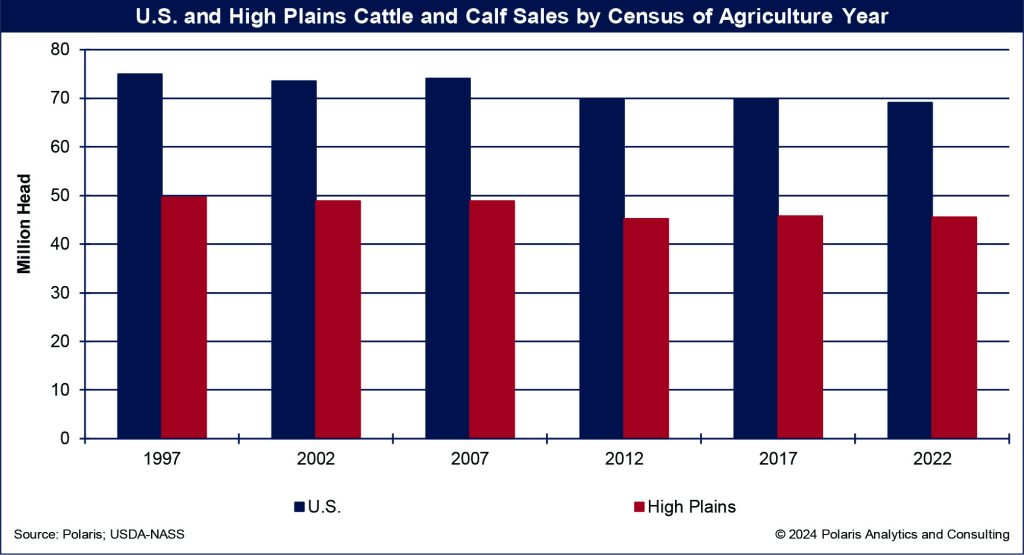Counting cattle and calves across the U.S. and the High Plains


The lore, dedication and determination of having a cattle and calf operation may have lost their luster, but not their value. In 2022, according to the Census of Agriculture of the U.S. Department Agriculture, there were about 593,000 farmers across the country who reported having a cattle and calf operation. That is a drop of nearly 60% or about 530,000 since 1997, when the USDA took over the quinquennial Census of Agriculture.
Across the High Plains states, the drop in operations with cattle and calves was not as steep, but down, nonetheless. In 1997, there were about 493,000 operations, and in 2022, there were 291,103 operations, a retreat of 49%.
The High Plains states account for an increasing share of cattle and calf operations in the United States, however, with 49% in 2022, up from 44% in 1997.
The number of cattle and calf operations in the U.S. and the High Plains is shown in the accompanying figure titled U.S. and High Plains Cattle and Calf Operations.

The number of head of cattle and calves from the operations has also shrunk, but not to the same extent. Across the U.S., farmers reported having 69.1 million head of cattle and calves on their operations during 2022. That is a drop of 5.9 million head or 8% since 1997.
Farmers in the High Plains reported having 45.5 million cattle and calves on their operations during 2022. This was a drop of 4.1 million or 8% since 1997.
The number of head of cattle and calf sales by Census of Agriculture year is shown in the U.S. and High Plains Cattle and Calf Sales by Census of Agriculture Year chart.

Cattle and calf sales are increasing, with High Plains farmers having more value per head and operation
While the cattle and calf herd size and number of operations has been shrinking over time, the revenue has not. In 2022, sales of cattle and calves totaled $89.4 billion across the U.S., up 88% or $48.5 billion in nominal terms since 1997, based on data from the Census of Agriculture.
Cattle and calf sales across the High Plains totaled $64.5 billion in 2022, also an increase of 88% but up $35.1 billion from 1997. While the High Plains has 49% of the operations in the U.S. and 66% of the number of cattle and calves, its market share of sales is 72%.
On a per head basis, the value of cattle and calves in the High Plains during 2022 was $1,417 and $1,294 across the U.S. Farmers in the High Plains enjoy a 9.5% higher sales value per head compared to the U.S. as a whole.
High Plains farmers had sales of $221,501 per cattle and calf operation, while U.S. farmers had sales of $150,720. Given that High Plains farmers have more cattle and calves per operation than farmers across the U.S., their operation revenues are 47% higher than other U.S. farmers.
Cattle and calf sales by Census of Agriculture year for the U.S. and High Plains is shown in the chart U.S. and High Plains Cattle and Calf Sales in Nominal Terms.

High Plains stands out as a top cattle-calves region
As a top cattle-calf producer and supplier, High Plains has several standouts. Texas has 35% of the cattle and calf operations across the High Plains region, 26% of the head count and 24% of the sales.
Kansas and Nebraska together represent 13% of the operations, 34% of the head count and 40% of the sales. For the region, Nebraska had the highest number of cattle and calves per operation in 2022 at 452 and Kansas the second most at 390.
Missouri has a relatively high number of cattle and calf operations, representing 13% of the High Plains, but its head count is less than 5%, and sales total 3%. The number of head per operation in Missouri was 59 in 2022. While not the lowest, it was the second fewest compared to Arkansas with 46 head per operation.
The High Plains region has the highest valued cattle and calves, totaling $1,471 per head in 2022, compared to $1,294 per head across the U.S. Five states were above the U.S. average, including (in descending order) Nebraska at $1,652 per head, Kansas at $1,648, Iowa at $1,588, Colorado at $1,565 and Texas at $1,325.
Sales of cattle and calves by operation for the High Plains were $221,501 in 2022 while the U.S. average was $150,720. Eight of the 12 states in the High Plains region had sales per operation that exceeded the U.S. level. Because Nebraska, Kansas and Colorado have more cattle and calves per operation, their sales per operation are in a league of their own. Nebraska’s cattle and calf operations had sales of $746,502 per operation, Kansas with $642,147 and Colorado with $478,452.
The farmers and ranchers of the High Plains region raise and deliver the cattle and calves of the U.S. They do so by harnessing the rich resources where they farm. Being a cattle and calf farmer and rancher has plenty of challenges with weather, commodity market volatility, feed costs, disease, animal health, government policy and shifting consumer preferences among other challenging issues to overcome. Based on the Census of Agriculture, many have left the cattle and calf sector, but there are plenty who continue to deliver the goods. It is a rewarding livelihood or way of life to support a family while providing sustenance to the consumer.
Census of Agriculture is a trove of information, taking much to herd it in
The Census of Agriculture is taken every five years. The USDA started releasing the results earlier this year. There is a large amount of meaningful data to be mined from the Census of Agriculture, and it is used by associations, seed, equipment, technology, financial institutions, investors, planners, policy makers and regulators and many others to help make strategic decisions and investments.
Being a cattle-calf operator is admirable, requiring fortitude and determination. Digging into the data of the Census of Agriculture can and does have its rewards for a rancher to sustain agriculture and his voice in feeding, fueling and providing the fiber of the U.S. and global economy.
Ken Eriksen can be reached at [email protected].



